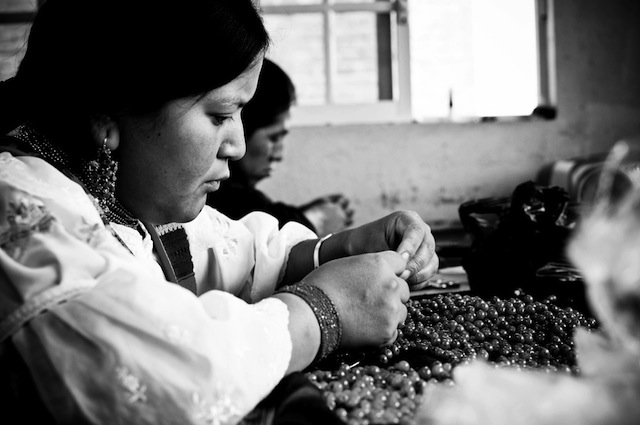
By Lane Florsheim
From multilayered bib necklaces made of smooth, vibrantly colored tagua beads to thick, hand-loomed alpaca shawls, the Andean Collection is full of exquisite statement pieces, a phrase that transcends its fashionable definition here. The jewelry and accessories that comprise the collection carry an important message about the potential for sustainable change in impoverished communities.
“I saw that most households were making jewelry as a secondary income,” she says. Judge saw a substantial opportunity for sustainable economic growth for these households through the accessories industry. Late in 2008, she started to work with a number of the artisans she had gotten to know through her research.
When the Andean Collection employs an artisan, the company finances his or her completion of the government-run training program that grants official artisan status in Ecuador, which complements the brand’s own training program. The Collection’s 2012 training program included instruction on financial management, computer literacy, and family planning.
To ensure they are fulfilling these complex objectives, the company administers a well-being survey once a year. The survey evaluates everything from income level to the type of roof and floor the artisans have to the number of electronics they own. “These are all indicators of quality of life,” Judge explains.
So far, the results have been remarkable. Judge told me about Nancy, one of the artisans employed by the Andean Collection who has been working with the company since its inception. Today, the Andean Collection is collaborating with Nancy to build up her own workshop and hire more employees; Nancy currently employs seven other artisans. Her income has increased by an astounding 800 percent, which Judge describes as the typical success rate for Andean Collection artisans. “The artisans are now living in the middle class,” she says.
Judge maintains a close connection to Ecuador and the Andean Collection artisans, traveling there from New York five times last year alone. She aims to ensure that the brand uses all-natural, local materials. Seeds have been used to make jewelry in Ecuador for generations, and the Andean Collection approaches traditional mediums and methods from a more fashionable angle.
What’s next for the Andean Collection? Judge highlighted recent travels to Swaziland and Cambodia, so look forward to even more distinctly beautiful jewelry””and expanding progress in alleviating global poverty”“in the near future.
Lane Florsheim is a senior at Tufts University where she is studying International Relations. She loves writing and reading about culture, politics, and women’s issues. Lane delights in jewelry making, captivating novels, and travel and exploration. Her personal website is available here. Follow Lane on Twitter @laneflorsheim.
All Photos Courtesy of the Andean Collection